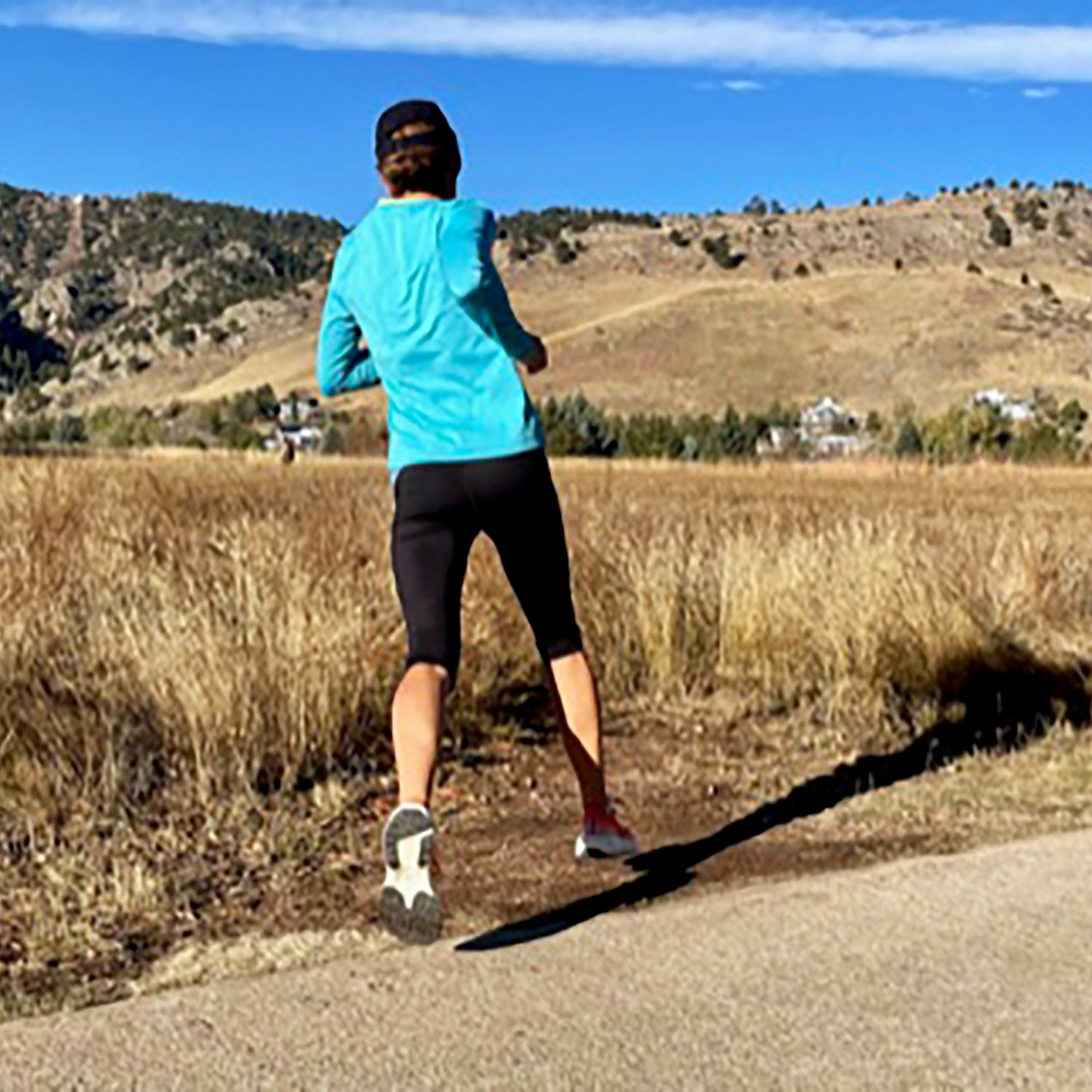In the past two years,�� a handful of brands have leaned into—or doubled down on—the category of shoe that can both run smoothly on pavement and keep you from falling on your face on a trail. Several brands, like Craft Sportswear and Salomon, have introduced what they’re calling their “Gravel” category of shoes, aiming to piggyback on the explosion in popularity of gravel cycling.
I’m a fan of the increased attention to the category, as I have always run a mix of road and trail within one run and love a good shoe that can handle multiple types of surfaces. But I’m finding there’s a difference between true road-to-trail shoes and gravel shoes.
What Road-to-Trail Shoes Excel At
A true road-to-trail shoe is perfect for my favorite neighborhood loop, which looks something like this: Walk down a sidewalk past a few houses to a path that cuts through the middle of a community garden. There, I run across wood chips, weeds, and hard dirt. Hit the sidewalk and run concrete for about a mile, crossing two busy streets and chugging up a steep, quarter-mile-long hill. At mile 1.3, I hit the ribbon of dirt next to a sidewalk that takes me to rocky singletrack through tall grasses up, and then down, a very steep, loose, rocky hill with a killer view of the Boulder Flatirons. Negotiate a very narrow, windy strip of dirt next to a sidewalk. Cross a paved street. Run tight singletrack through grassland over rocks and ruts and that climbs gradually, then steeply to the highpoint of my run. Descend a dirt fire road riddled with rocks and ruts and with steep wooden steps at the bottom. Run pavement roughly a half-mile downhill, hop up onto the sidewalk, cross a busy street. Run on concrete sidewalks home.
For the kind of runs where the surface changes from road to trail and back a few times, I want a shoe that can handle all sorts of terrain. A straight-up road running shoe and its cushioning and flexibility would offer a smooth ride on the paved sections, but lack traction, protection, and security on the trail segments. A trail-specific shoe, on the other hand, would keep me sure-footed and secure on the rugged dirt sections, but would feel clunky on the road.
I basically want a well-cushioned shoe with traction that doesn’t clunk on roads but that makes me surefooted on dirt, and that keeps my foot secure and comfortable. And I want that shoe to be “runnable”—flexible like a road shoe, not stiff like a hiking shoe.
The kind of dirt I run on this loop (and many other road-to-trail routes I run) is not mild crushed gravel; it’s more rugged than that. For that reason, I need a shoe that has lugs that grip and an upper that secures my foot in place. I don’t want my foot sloshing around on a technical trail, especially going up- or downhill.
What Gravel Shoes Excel At
Gravel shoes, in contrast, excel on just that: gravel. They have lightweight, comfortable uppers like road shoes, with some midfoot hold, just not as much as many trail shoes. Their outsoles mimic gravel bike tires, with small lugs in the center and larger ones on the perimeter of the shoes—to roll smoothly while gripping loose gravel. In shoes with this lug pattern, you don’t have to worry about spinning out on loose dirt or gravel like you would in road running shoes.
Today’s gravel shoes kick the snot out of pure road running shoes for running on groomed trails like the gravel path around the Boulder reservoir or the dirt backroads of the high plains. They also run much more smoothly on road than most trail running shoes. But road-to-gnarly trail runs require midfoot hold and better traction than many gravel shoes offer.
My point: There’s a difference between road-to-trail and gravel shoes, there’s a time and place for each, and I appreciate both. Here are my current favorites from the latest releases in both categories.
My Favorite Road-to-Trail Running Shoes
Nike Pegasus Trail 5
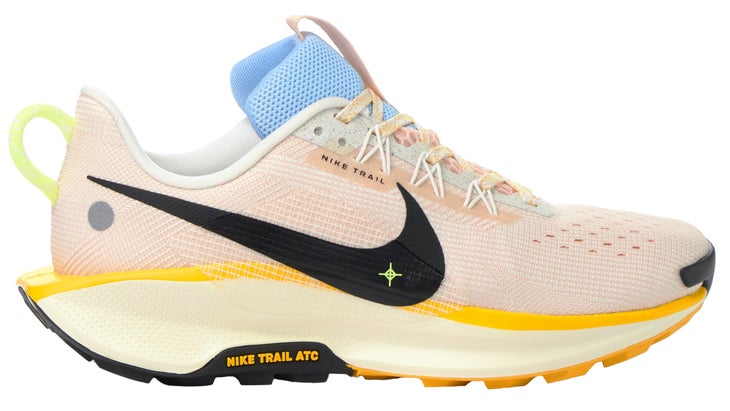
9.5 oz (men’s); 8.5oz (women’s); 9.5mm offset
This shoe has become my favorite road-to-trail pick, mostly because the midfoot hold feels secure enough to give me confidence on rugged trails, not just flat, gravel roads. I credit the Flywire technology—thin, lightweight but strong thread—connecting the laces to the strobel board (underneath the insole) for that secure feel. Nike’s ReactX midsole foam feels lively on roads without being too thick or bouncy on trails. The outsole rubber—Nike’s All Terrain Compound (ATC)—isn’t as grippy as the Vibram Megagrip on Nike’s Ultrafly trail shoe, but the low-profile (3.5mm lugs) do a decent job on technical trails and run fairly smooth on roads. I also like how the rubber wraps around the front of the shoe to protect my toes if (when) kicking rocks and roots.
Best for: Those who want a comfortable, good-looking, truly versatile shoe that can handle rugged trails and run relatively smoothly on roads. This is a good travel shoe.
Craft Nordlite Ultra
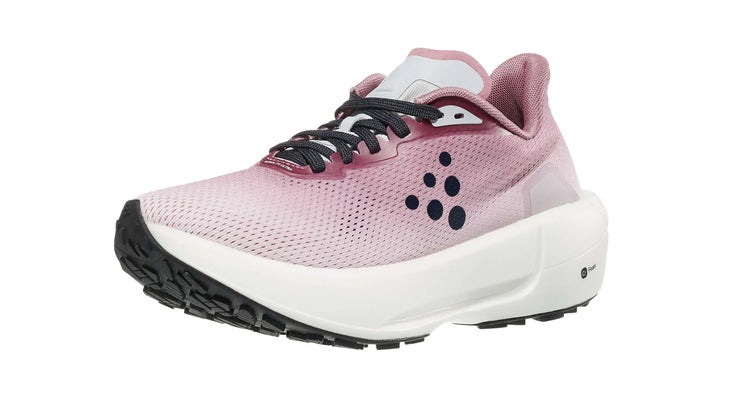
9.3 ounces (men’s), 8.1 ounces (women’s); 6mm offset
This shoe, my top pick last year, still ranks among my favorites for road-to-trail runs. An ample amount of responsive cushioning (40mm under the heel and 34mm under the forefoot) helps this shoe to feel great on hard surfaces, both road and super-firm Colorado dirt. The heel and forefoot portions of the mid- and outsole are decoupled, allowing each segment to move slightly independently, which I find works great on rocky terrain and pavement alike. It’s flexible for smooth running on roads and gives me agility on the trails as it morphs around rocks, delivering a unique ride that I really enjoy. The outsole’s 3.5mm lugs—some smaller, some larger—do a great job grabbing both loose surfaces and rock while not being so deep that they feel cumbersome on roads. The one-piece mesh upper is comfortable, but I sometimes crave a bit more support/foothold on technical trail sections.
Best for: Those who like a flexible sole with substantial cushioning, a comfortable upper, and enough grip to tackle mildly technical trails.
On Cloudvista 2
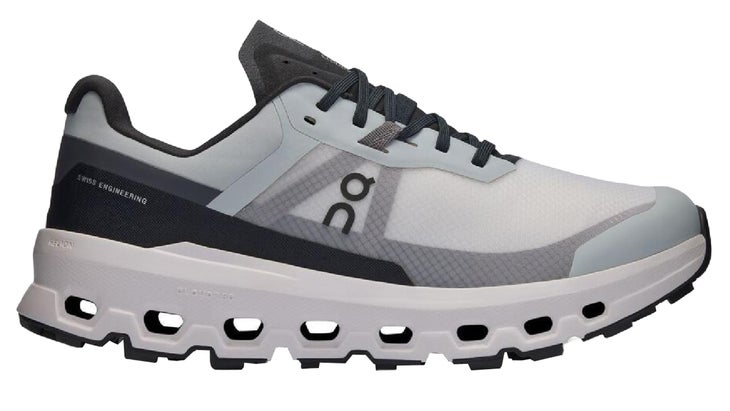
10.5 ounces (men’s), 8.6 ounces (women’s); 6mm offset
This shoe surprised me, perhaps because of its inconspicuous looks—the monomesh upper is sleek and somewhat hides some key performance features within the shoe. The mesh on its own keeps out debris and worked great in fresh snow, shedding moisture, even though it’s not necessarily geared toward water-resistance. And underneath that mesh is a webbing system connecting the laces at the midfoot to underneath the insole (somewhat similar to the Nike Flywire system). The effect is a secure foothold that allowed me to tackle technical terrain without feeling like my feet were slipping within the shoe. On roads, the proprietary Helion foam (gas infused for lightness and rebound) and On’s Cloudtec pods feel responsive underfoot, while the 3mm traction lugs weren’t clunky. A two-pronged, semi-flexible speedboard inserted in the midsole adds to the underfoot stability and responsiveness—and delivers the classic On ride. One knock: A thin tongue and thin laces made for some pressure on the top of the foot.
Best for: On devotees, those who want exceptional foothold, a stable ride, and responsiveness for road-to-rugged trails or gravel.
My Favorite Gravel Running Shoes
Craft Xplor
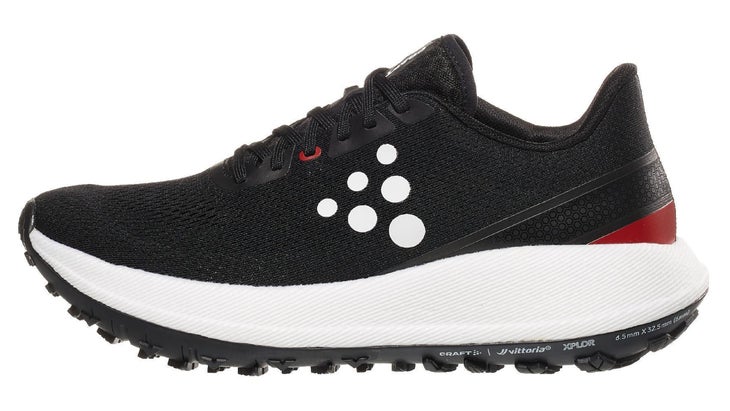
10.5 ounces (men’s), 8.8 ounces (women’s); 6mm offset
Craft goes all-in to the gravel shoe category with the Xplor. The outsole pattern—smaller lugs down the center and larger around the perimeter—are meant to mimic a gravel bike tire. It’s a design the brand developed with cycling brand Vittoria, and it grips loose dirt and gravel as intended, while staying out of the way when the surface is smooth and firm. Craft’s proprietary Px foam (40mm under the heel and 34mm under the forefoot) provides a lively, fun, joint-saving platform for both road and hard dirt/gravel surfaces. The midsole noticeably flares out from the upper, which, combined with the ample foam, creates a stable ride. When the terrain turned to anything off-camber, steep, or technical, I craved a more nimble feel from a more secure midfoot hold.
��Best for: Those who run road-to-gravel, road-to-smooth, flat dirt, gravel only.
On Cloudsurfer Trail
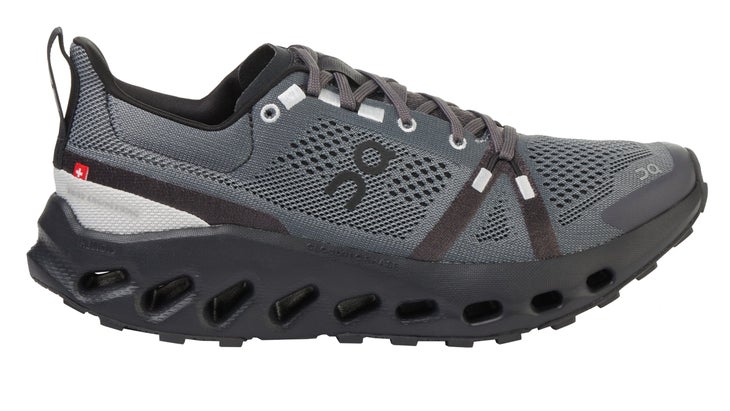
9.7 ounces (men’s), 8.3 ounces (women’s); 7mm offset
This is a very comfortable, smooth-running shoe. The brand’s CloudTec Phase tech—open pods in the midsole made out of Helion foam, a proprietary gas-infused Pebax blend—are soft and cushy. The shoe has a slight toe spring, which seems to help it roll smoothly on roads and mild off-road terrain. The outsole features low-profile lugs made out of the brand’s MissionGrip, which does a good job even on rock. But what keeps this shoe off my “favorites” list for my go-to local loop is the somewhat loose-feeling upper. It’s a comfortable upper, but it doesn’t hold my narrow foot securely enough to let me hop around rocks and ruts with confidence. Still, this is a smooth-rolling, versatile shoe if you keep it on the gravel.
Best for: Those looking for a super-smooth ride on roads, paths, and light trails.
Salomon DRX Defy Grvl
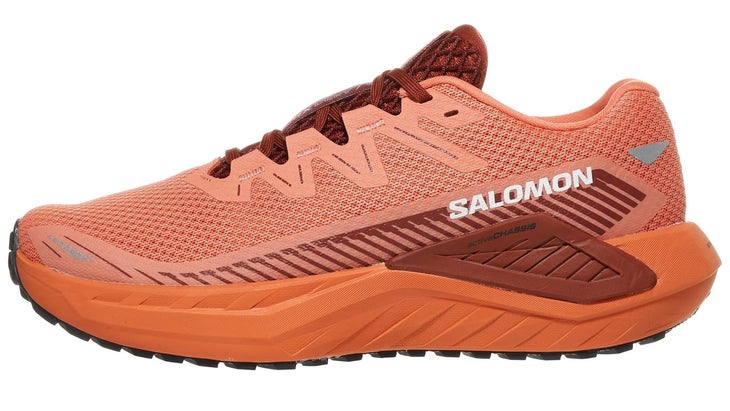
8.7 ounces (men’s), 8.0 ounces (women’s); 8mm offset
The DRX Defy Grvl is Salomon’s foray into the cross-over shoe category, and they’re going all-in with the name and design of this shoe. Like the Craft XPLOR, the outsole is modeled after a gravel bike tire, with small lugs in the center (although, only under the forefoot), and larger, chevron-shaped lugs around the perimeter. The pattern works well on gravel and loose dirt. With its Active Chassis—the brand’s siderails made of dense foam to offer guidance—this shoe feels more like a stable road shoe than others on this list. Negative space in the middle of the outsole/midsole also adds a dampening effect, adding to the road shoe-like feel. The upper has enough structure to keep feet from sloshing around on trails, but the shoe feels more at home on moderate rather than rugged terrain.
Best for: Those seeking mild stability in a road-to-gentle trail/gravel crossover shoe. Those who prioritize a lightweight shoe.
Hoka Challenger 7
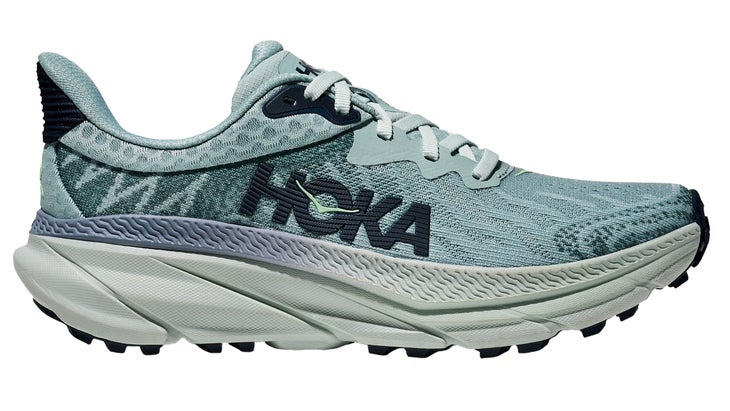
8.9 ounces (men’s), 7.7 ounces (women’s); 5mm offset
I’m putting the Challenger 7 to the “Gravel” section of this season’s roundup mostly because it doesn’t handle technical terrain as well as some of the others. I chalk that up to the thick midsole (31mm/26mm for men, 29mm/24mm for women), which makes the shoe more of a monster truck than a ninja. It rolls over terrain, but lacks midfoot stability and ground feel, which makes me a little trepidatious on the technical stuff despite 4mm lugs made of a fairly basic durabrasion rubber. The company says the outsole pattern—small lugs in the center, larger around the perimeter of the shoe—is inspired by gravel bike tires, and the Challenger ATR 7 is super comfortable, and capable, on smooth gravel terrain.
Best for: Hoka devotees, those seeking max cush, heavier runners, those who run gravel roads and road-to-smooth-trail routes.


